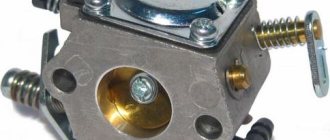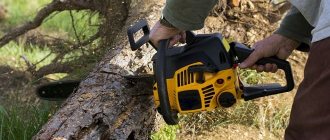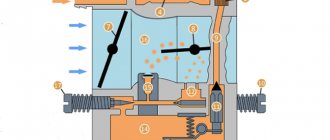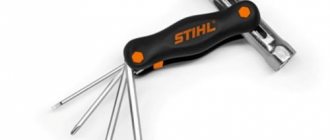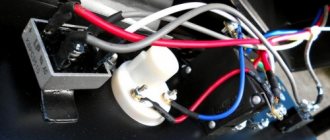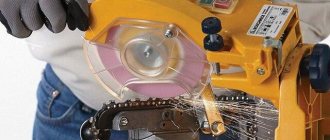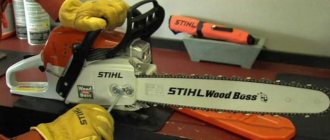Why the spark plug on a chainsaw floods: reasons
The key reason for a flooded spark plug on a chainsaw is an excessive amount of fuel and this can be caused by various reasons, in particular:
- Poor quality gasoline.
- Incorrect algorithm for starting a chainsaw, which is often the “sin” of inexperienced owners.
- A clogged air filter that no longer copes with its function.
- Ignition system failure.
- Unadjusted carburetor operation.
Troubleshooting Tips
In the first case, the problem is solved by bringing the air intake device into working order. It is recommended to blow out an exhausted paper filter with a reverse air flow or, at best, replace it. Refer to the supplied instruction manuals for cleaning methods for other types of filters.
- The carburetor is adjusted with the engine warmed up to operating temperature. The power unit is brought to optimal mode by rotating the adjusting screws for the quantity and quality of the mixture. The success of the work is determined by knowledge of the design of the fuel supply system and the interaction of all components.
- In particular, the increased complexity of adjusting carburetors with built-in compensators and other automatic control elements. Such equipment is configured using special equipment that is supplied to service and repair centers.
If the engine cannot be tuned, the cause of excess fuel in the emulsion may be a leak in the valve or a stuck carburetor float itself.
The final result of the work performed:
- fast acceleration;
- stable operation at idle;
- restoration of traction parameters;
- absence of increased smoke and detonation noise.
What to do when a candle on a chainsaw fills
Before heading to the service center, it would be a good idea to try to fix the current malfunction of the spark plug on your chainsaw yourself. Of course, this is only relevant if you have “direct” hands, since, otherwise, there is a high probability of increasing the cost of repair work.
Poor quality fuel
The chemical composition of low-octane gasoline includes various alcohol components. Their complete combustion requires more time than when using high-quality fuel, and accordingly this becomes the main reason for the failure of the chainsaw spark plug.
Unfortunately, many citizens naively believe that fuel containing alcohol has a positive effect on gasoline consumption and purchase fuel substitutes. In some cases, efficiency does occur, but such fuel has a negative effect on the chainsaw engine, shortening its service life.
Incorrect start
As a rule, during the first start of a chainsaw, inexperienced men miss a “pop” when the air damper is closed and continue to pull the starter. Because of this, a large amount of fuel accumulates in the combustion chamber, but there is a critical lack of air. The spark plug is filled with excess gasoline and there is no longer any spark to speak of.
Clogged filter
Due to severe contamination of the paper filter of the chainsaw, a sufficient amount of oxygen does not enter the fuel chamber. The fuel mixture does not have time to ignite and gasoline floods the spark plug.
If the filter has already exhausted its service life (this will be noticeable by its appearance), then it must be replaced.
If you don’t have a new filter at hand, but you still need to work, you can try blowing the filter with a reverse air flow.
Chainsaws from different manufacturers and model ranges differ from each other. To clean or change the filter, it is a good idea to first look at the instruction manual. Well, or look there if you can’t remove the filter without prompting.
Ignition system failure
Perhaps this is one of the most difficult problems that will need to be overcome in order to continue using the chainsaw. There may also be several reasons for the malfunction here.
We also recommend reading about the design of a chainsaw; this information will greatly help in solving problems.
Incorrect clearance
For the most part, the gap on the chainsaw's spark plug should be within 0.5 - 1.2 millimeters (more accurate data should be reflected in the user manual). In order to check if this is so, you need to do the following:
- Using a screwdriver or special keys, unscrew the bolts securing the chainsaw cover.
- Having gained access to the flywheel and magnetic core, the clearance level is checked.
- If it does not correspond to the characteristics declared by the manufacturers, then using a special gasket or improvised means (an ordinary A4 sheet folded several times is perfect) the required distance is set.
Ignition coil problem
To make sure that the ignition coil is working properly, you need to be able to use a multimeter. This device allows you to measure the degree of resistance of the coil. A good coil will have resistance. In a burnt out one there is a break or a short circuit.
If the coil is working properly, then the gap between the coil and the flywheel may be broken. To set it up, you need to perform a number of simple steps:
- Dismantling the saw body and loosening the bolts that secure the ignition system. The magnet (magneto) of the flywheel must be connected to the coil itself.
- The adjusting plate is inserted between the flywheel magneto and the coil itself. The gap should be within 0.2 mm.
- After tightening the bolts, the adjustment plate is removed.
- It is imperative to rotate the flywheel completely and several times (2-3 will be enough). However, it should not cling to the coil.
- The final stage is assembling the chainsaw body.
We also recommend reading an article about the ignition system and how to check its coil with a multimeter; it explains all the nuances and gives tips on how to troubleshoot problems yourself.
Carburetor adjustment failure
Often the spark plug on a chainsaw is flooded due to improper operation of the carburetor. For greater clarity, we recommend watching this video
If this is your first time setting up a carburetor yourself, pay attention to the following factors:
- The presence of built-in compensators and other automatic control elements makes adjustment impossible without special equipment. In this regard, you will have to contact a specialized service center.
- If there is no proper effect from adjusting the carburetor, the cause of flooding of the spark plug will be a stuck float or a lack of tightness of the valve.
How does the Shtil 180 carburetor work: device, principle of operation
The main components of the Shtil 180 chainsaw carburetor include the following components:
- fuel pump (with internal diaphragm);
- main (membrane) chamber;
- diffuser;
- throttle and air dampers;
- needle valve;
- fuel jets;
- nozzle with valve;
- idle speed adjusting screw.
The principle of operation is this. The chainsaw crankcase is connected to the fuel pump in the carburetor by a special channel. Due to the alternating stroke of the piston, a vacuum is created in the engine crankcase. Due to this, the diaphragm in the fuel pump rises and the valve opens to supply fuel to the carburetor.
Next, the fuel passes through the filter element (mesh) and enters the main chamber through a special channel. A control membrane is installed in this chamber, which regulates the fuel supply by pressing the rocker arm, which in turn lowers the needle valve.
Raising the control membrane is responsible for the vacuum that occurs in the carburetor diffuser due to the rotation of the air throttle valves. As soon as the engine starts, the mixture needs to be leaner. We lower the air damper, the vacuum in the diffuser is minimal, and the membrane falls into place.
From the main chamber, fuel enters the diffuser using a nozzle with a check valve, or through idle jets (when the gas throttle is closed). There it is mixed with the intake air and the finished mixture enters the engine cylinder. The check valve prevents air from the diffuser from entering the main chamber.
What to do if the spark plug is flooded on the chainsaw
If you suspect a flooded spark plug, you need to inspect it. Using a spark plug wrench, it is unscrewed and carefully examined. If the spark plug is wet, but there is a spark, then it has definitely been flooded.
Proper preparation of the fuel mixture also affects the life expectancy of the spark plug and can also damage it; read about the proportions in which to mix gasoline and oil here.
Many experienced owners are able to determine with a high degree of probability the current condition of a candle by its color. It is recommended to carry out this procedure regularly.
- Light brown soot is exactly what all owners want to see. In this case, the functionality of the chainsaw is not impaired.
- Black carbon deposits indicate an unbalanced mixture, namely a lack of oxygen in the fuel chamber. If the situation does not improve, there is a high probability that the chainsaw spark plug will flood again.
- If corrosion is detected on the fork or the distance between the electrodes is too large, then most likely a lean fuel mixture is used.
Troubleshooting Tips
If the chainsaw spark plug has been flooded and you do not want to wait for the fuel to drain, there is a fairly effective and quick cleaning method.
- If the repair is carried out in the field, then the saw is installed on a flat surface (everything is easier in the workshop - a table will help), after which the explosive wire from the spark plug is pulled out and the spark plug is taken out using a key, its spark plug electrodes are wiped dry. In this case, the circuit breaking system must be turned on.
- The air filter cover is unscrewed and cleaned of dirt.
- After this, the control lever is set to the minimum throttle position, and the starting cord is pulled up to 10 times, but not less than 5. Thus, the combustion chamber is cleared of excess fuel.
- After replacing the air filter, installing the spark plug and connecting the wire, you should pull the starter cord a few more times. At the same time, the throttle valve must remain open.
If these actions are performed correctly, the saw will “come to life” again.
Most owners of chainsaws have filled the spark plugs more than once and at the same time have themselves returned the functionality of the tool more than once. Don’t be afraid of this problem: straight-growing hands and the presence of a user manual will help you continue to use the tool without going to a specialized center.


